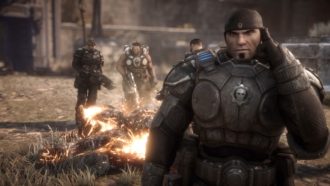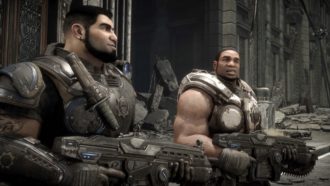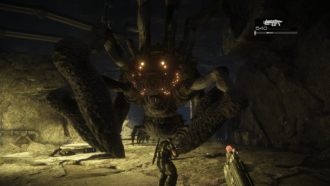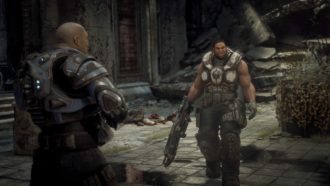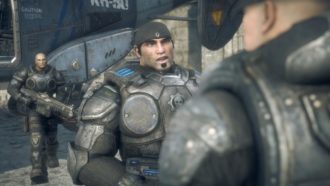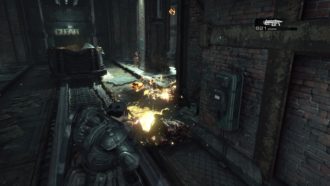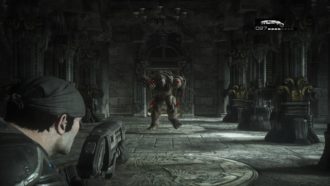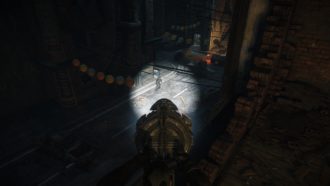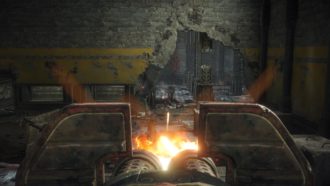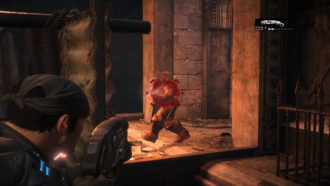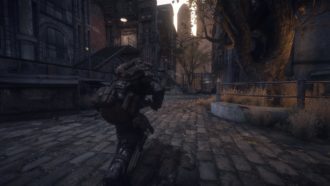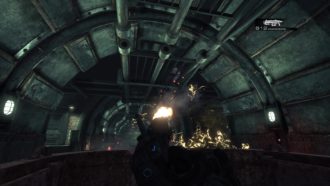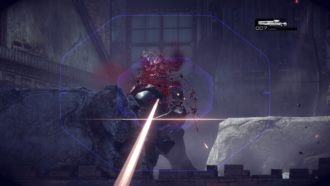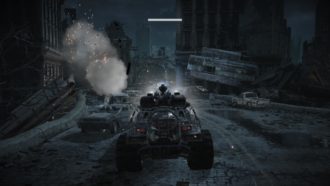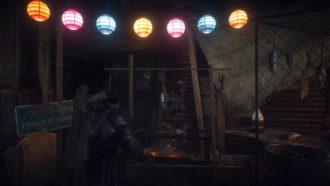Platforms:
PC, PS5, Xbox Series X|S
Released:
August 26, 2025
Publisher:
Xbox Game Studios
Developer:
The Coalition
Few games have left as deep an imprint on modern shooters as Gears of War. When it launched on the Xbox 360 in 2006, it set a benchmark for console graphics and established cover-based shooting. The Lancer’s chainsaw bayonet, the weighty roadie run, and the tension of ducking behind cover as bullets whizzed overhead became part of gaming history.
Almost twenty years on, Gears of War: Reloaded is here to bring that legacy back, now also for the very first time on PlayStation. For Xbox veterans, this may feel like another excuse before next year’s Gears of War: E-Day. For PlayStation fans, it’s a historic opening of the floodgates after years on the other side of the console divide. The result is a game that’s still fun, still historically important, but still dated.
Emergence Day, again
The story of Gears of War wears its simplicity proudly. You play Marcus Fenix, a disgraced soldier busted out of prison by his best mate, Dom Santiago. Humanity is on its knees, under siege from the subterranean Locust Horde. You’ve got to link up with your squad, plant a resonator to map the enemy’s underground tunnels, and give the Coalition of Ordered Governments (COG) a fighting chance.
For newcomers, it’s worth noting just how stripped back the narrative is compared to modern blockbusters. There are no side quests and no branching choices. Dialogue is punchy, often cheesy and sometimes with an exposition dump, and more concerned with bravado than nuance. Marcus is the stoic grunt, Dom the loyal heart, Cole the comic relief, and Baird the snarky tech guy. They’d all evolve into deeper characters in later games, but here they’re broad archetypes.
“…make no mistake, the story and characters show their age.”
Delta Squad have a dynamic that flits between endearing camaraderie and B-movie ham. The dialogue, to today’s standards, mostly lands flat. Dom’s repeatedly shouted “take cover!” and the likes lack the punch you’d expect in 2025, but there’s a certain charm still there. It’s war theatre, and the characters remain iconic because of it.
In an era of branching dialogue trees and sprawling RPG systems, it’s almost liberating to just be told where to go, what to shoot, and why it matters. Still, I was initially bored by the first few beats of the story; only when Delta Squad heads into the depths of the planet to recover the resonator, did I become more engaged. But make no mistake, the story and characters show their age. Where later entries deepened the cast and themes, here they’re stereotypes played straight.
Ruins of Sera 20 years later
What stands out most about replaying Gears of War: Reloaded is how refreshingly straightforward the gameplay is. This is a pure linear shooter where every mission is designed to push you forward. You aren’t managing loot, upgrading skills, or wandering open zones. Just shooting Locust until they stop coming, then moving to the next shooting gallery.
That simplicity is a double-edged sword. On one hand, it’s blissfully simple. The game wastes no time with filler, and the pacing is an excellent 8–10 hours of combat that escalates steadily with new enemy types, set pieces, and weapon introductions. On the other hand, it lacks depth compared to modern shooters. Once you’ve played through a couple of acts, you’ve seen most of what it has to offer mechanically.
“Gears 1 maintains a smaller and more focused approach… sells the sense of being one squad lost in a much bigger, hopeless war.”
Some mission gimmicks break up otherwise repetitive gameplay. The night Kryll sequences in Act II, where you stay in lit areas by shooting gas canisters, are still creative enough to keep your interest. Path-splitting sequences, where you and your co-op partner take different routes, add variety and are still sort of unique in a shooter like this today. But other sections, like the Berserker escort from Act I, remind you how clunky the 2006 design can be.
I still remember playing that fight for the first time at a friend’s house, sweating bullets as I tried to lure her outside for the Hammer of Dawn strike. Replaying it now, the encounter hasn’t aged gracefully, the AI is clunky, and I realise the tension was all in how clumsy the section was. Still, it triggered an odd rush of nostalgia that reminded me why it stuck in my head all those years ago.
The world itself, however, holds up. The destroyed beauty aesthetic is still evocative, with crumbling buildings and empty streets creating an eerie mood. Level after level barrels forward with no loading screens, and before you know it, you’re at the end credits. I found myself surprised at how easy it was to keep playing just one more chapter. While later sequels expanded the scope of the world, Gears 1 maintains a smaller and more focused approach. It leaves more to the imagination and sells the sense of being one squad lost in a much bigger, hopeless war.
Active reload or jammed clip?
The beating heart of Gears of War has always been its combat loop of duck into cover, empty a clip into Locusts, flank when possible, and revel in the pleasure of a well-timed active reload. Reloaded doesn’t mess with this formula, and that’s both a blessing and a curse. The cover system still works brilliantly. Epic’s original innovation, snapping to walls and blind firing, is as intuitive today as it was in 2006. Combat is satisfying, especially on higher difficulties where reckless play will get you punished fast.
“Combat is satisfying, especially on higher difficulties where reckless play will get you punished fast.”
The weapons remain some of the most iconic in shooter history. Chainsawing a Locust in half with the Lancer is just as gleefully grotesque as ever. The Gnasher shotgun is devastating in close quarters, the Hammer of Dawn is a powerhouse, and the Torque Bow’s glowing arrows are still one of the most satisfying projectile weapons.
The problem is that everything feels heavier than it should. Sprinting with the roadie run still locks you into an exaggerated shaky-cam animation that feels clunky by modern standards. Inputs have a slight delay, so sliding into cover or sprinting out doesn’t feel as responsive as it should. What once felt gritty and weighty now feels more like unnecessary sluggishness.
Enemy AI hasn’t aged well either. Locust often hunker down in predictable cover patterns, and while flanking still works, fights can become tiresome. Worse, your squadmates’ AI is a liability. On Hardcore difficulty, Dom constantly went down, forcing me to risk revives. Sometimes he’d even wander into Kryll-infested darkness and die instantly. Not to mention the handful of times where the game wouldn’t progress because an ally was stuck behind cover or just not moving close enough to the next door for it to trigger the sequence to move on. It’s frustrating, and it undercuts the brotherhood theme when you’re mostly babysitting them.
Little extras for longtime fans
Multiplayer hasn’t changed much since Ultimate Edition, but it’s still fun. All maps and modes return, servers now run at 60Hz, and 120fps support makes matches smoother. That said, it feels barebones compared to modern multiplayer shooters. No progression systems, no Horde mode. Horde’s absence especially stings, since it became a franchise staple from Gears of War 2 onwards. Including it with a server list to minimise matchmaking time would have been a brilliant way to modernise Reloaded, but as it stands, the multiplayer feels like a museum piece.
“…bonus material that rewards nostalgia more than it does new players, but it’s welcome all the same.”
Beyond the core offering, Reloaded includes a few nice touches for fans who’ve been here before. Collectible COG tags once again unlock pages from the official Gears of War comics, which is a thoughtful nod for players who want to dig deeper into the lore. Concept art and multiple sets of credits (for the original, Ultimate Edition, and Reloaded) also show developers The Coalition’s commitment to acknowledging the game’s legacy.
Now, I’ve reviewed six remasters/remakes this year in different forms and with different budgets. While some have made exceptional changes and additions to bring them into the present day, such as Tony Hawk’s Pro Skater 3 + 4, others have lacked significant bonuses or improvements for fans, like Star Wars Episode 1: Jedi Power Battles. I’ve seen it all. Gears of War: Reloaded doesn’t change the gameplay experience in a meaningful way, but as a package, it adds a great sense of celebration. It’s the kind of bonus material that rewards nostalgia more than it does new players, but it’s welcome all the same.

A shiny coat of paint
Reloaded is a big step up from Ultimate Edition. Campaign now runs at 4K/60fps, multiplayer can hit 120fps, and textures, lighting, and shadows have all been upgraded. The HDR implementation makes dark areas more atmospheric, while richer colours replace the old grey-and-brown palette.
There are loads of small environmental touches, too. Areas full of crumbled structures, more detailed and bloody scenes of death, and clearer views of the world outside of the main level area, which add layers of immersion. The game feels closer to a modern title, even if you can still see its mid-2000s roots. That said, it’s not transformative. There’s no ray tracing, no rebuilt models, and no radical visual overhaul. It looks good, but not mind-blowing. More like a high-end PC mod of Ultimate Edition.
Audio, meanwhile, is a mixed bag. Gunfire and explosions sound great with spatial audio, and Dolby Atmos adds depth to firefights. But voice acting and dialogue mix are dated. Lines occasionally drop out, and aside from the already mentioned wooden performances, they often sound oddly muddy or lost within the rest of the audio. Luckily, the memorable score holds strong and is always the driving force behind the bigger boss battles.
“Couch co-op is still here too, a rarity these days, and honestly the best way to play.”
One of the most exciting changes is simply seeing Gears on PlayStation for the first time. Holding a DualSense while Marcus Fenix grumbles about Locust is a promising sign of more to come, but the console-specific features are what are most welcome. Adaptive triggers add resistance to firing guns, and radio chatter coming through the controller speaker is a nice touch. It doesn’t revolutionise the game, but it adds value for those wanting to play it again.
Cross-play and cross-progression are genuinely fantastic additions. Being able to play campaign co-op with a mate on Xbox or PC, or carry your progress across platforms, makes Reloaded feel much more accessible. Couch co-op is still here too, a rarity these days, and honestly, the best way to play.
6.5
Decent
Positive:
- Historic and iconic gameplay
- Great technical upgrades
- Cross-play and cross-progression
- DualSense is the best way to play
Negative:
- Dated story and characters
- Sluggish controls
- Poor AI
- Barebones multiplayer
Gears of War: Reloaded is the definitive version of Gears 1, but only by default. A faithful remaster of a remaster that keeps the series alive and opens the door to PlayStation players, but doesn’t do enough to feel essential. It’s both dated and timeless, clunky and exhilarating, simple and unforgettable. A solid nostalgia trip, but a missed opportunity to make the original shine for modern audiences.
